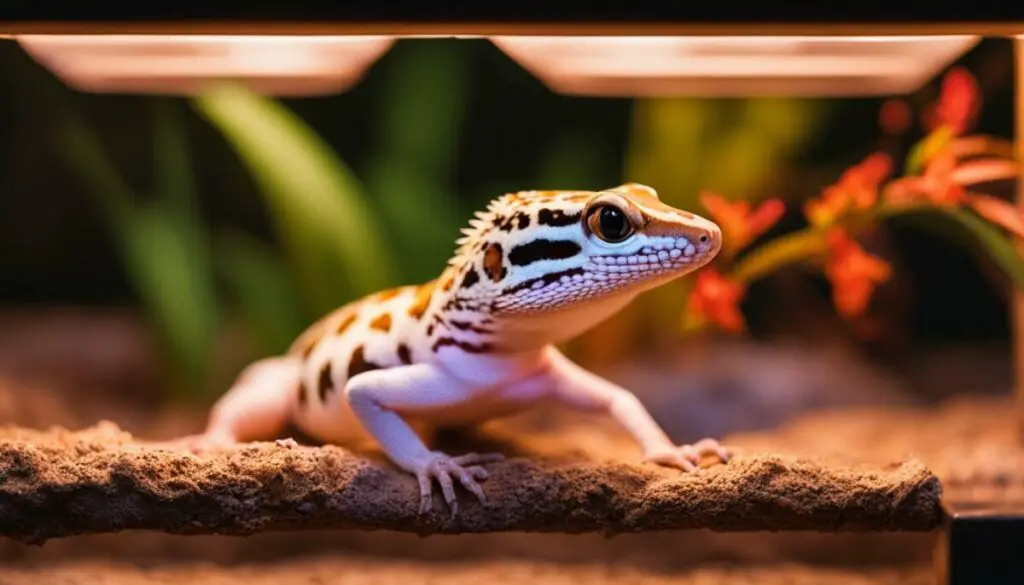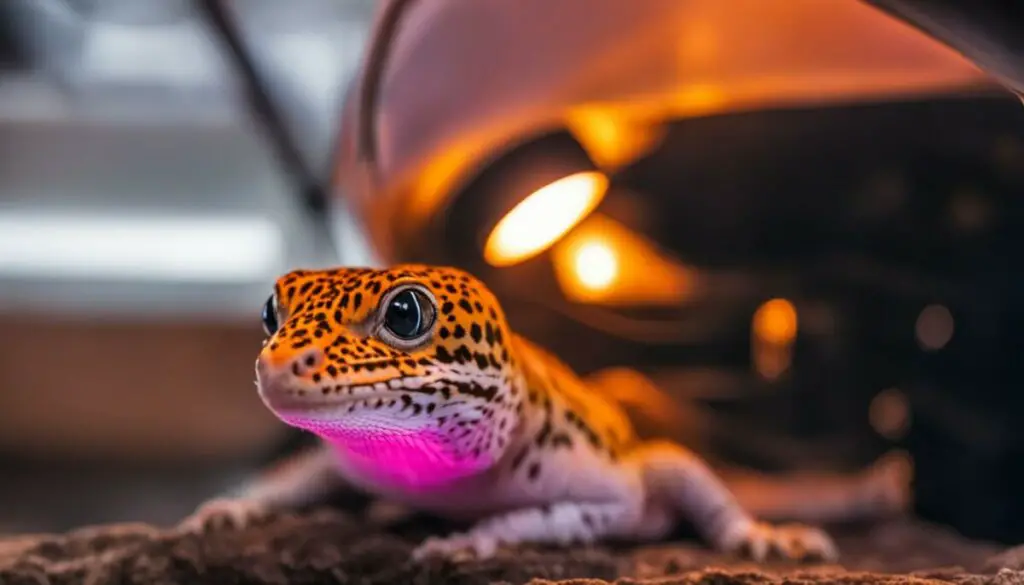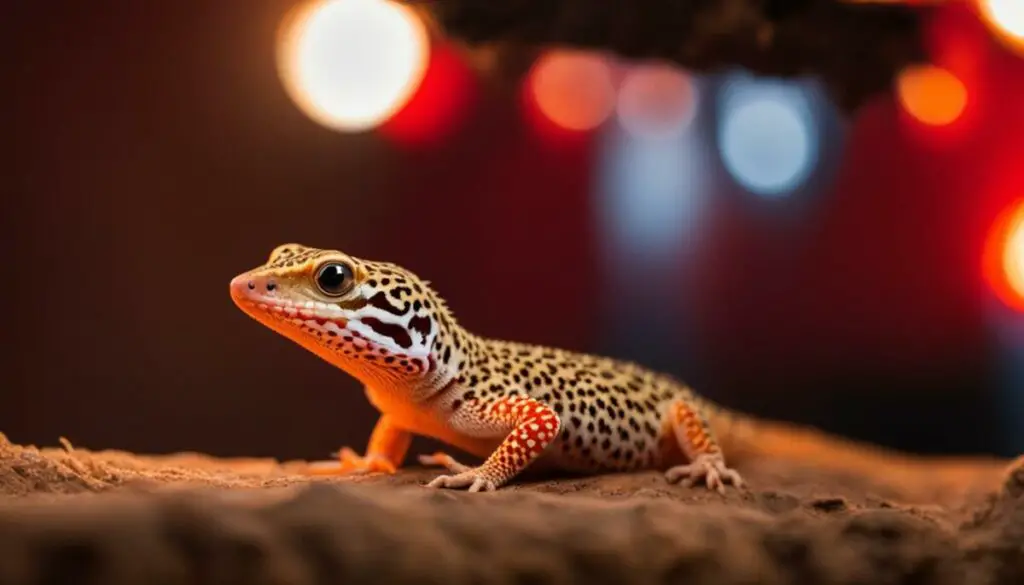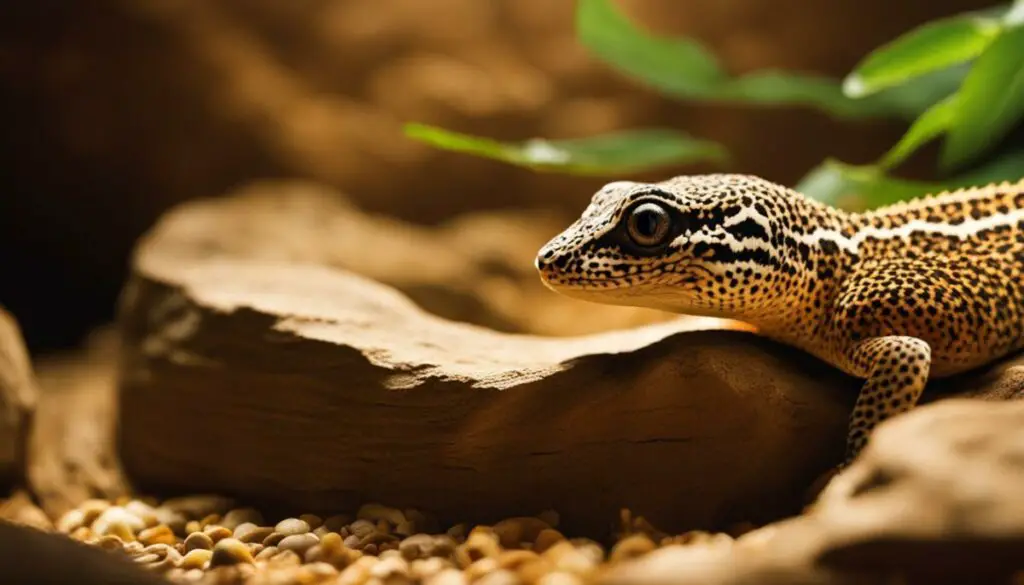Last Updated on 4 months by Francis
Leopard geckos are fascinating reptiles that require proper care and attention to thrive. One important aspect of leopard gecko care is providing the right heating and lighting in their enclosure. When it comes to reptile heating, it’s essential to understand the impact of different types of lights, including infrared lights, on the health and well-being of leopard geckos.
Leopard geckos are crepuscular, meaning they are most active during twilight hours. To create a suitable environment for these reptiles, a balanced pattern of light and darkness is necessary. This includes providing the right kind of lighting during the day and night.
When it comes to infrared lights, there are mixed opinions on their effects on leopard geckos. While infrared lights can provide warmth, they may not be the best option for leopard geckos. Leopard geckos require a specific balance of light and darkness to maintain their internal clock and natural behavior.
It is recommended to use a 5-element setup for leopard geckos, including an incandescent heat lamp as daylight, a ceramic bulb for nighttime heating, and a red, blue, or black night light for observation. By mimicking the natural day-night patterns of their Middle Eastern habitat, you can help maintain their health and well-being.
It’s important to note that leopard geckos have sensitive eyes, and prolonged exposure to bright light, such as infrared lights, can disrupt their natural behavior and sleep patterns. To ensure their health, it’s best to use specialized bulbs designed for reptiles, such as incandescent bulbs and full spectrum daylight bulbs.
Now that we’ve covered the basics, let’s take a look at some key takeaways:
Contents
Key Takeaways:
- Leopard geckos require a balanced pattern of light and darkness to maintain their internal clock and natural behavior.
- A 5-element setup, including an incandescent heat lamp, ceramic bulb, and a night light, is recommended for leopard gecko care.
- Infrared lights may not be the best option for leopard geckos as they can disrupt their natural behavior and sleep patterns.
- Using specialized bulbs designed for reptiles, such as incandescent bulbs and full spectrum daylight bulbs, is important for leopard gecko health.
- Mimicking the natural day-night patterns of their Middle Eastern habitat helps maintain the well-being of leopard geckos.
Lighting Needs and Requirements for Leopard Geckos

Leopard geckos have specific lighting needs that are essential for their health and overall well-being. By providing the right lighting setup, you can create a proper day-night cycle in their enclosure and ensure they thrive in a simulated natural environment.
To meet the lighting requirements of leopard geckos, it is recommended to use a 5-element setup or a 4-element setup, depending on your preference and the specific needs of your gecko. This setup includes a combination of daylight bulbs, nighttime bulbs, and ceramic bulbs for heating.
Daylight bulbs, also known as full spectrum daylight bulbs, are designed to mimic natural sunlight and provide the necessary visible light for your leopard gecko. These bulbs help create a bright and well-lit environment during the day, enabling your gecko to engage in natural behaviors such as exploring and hunting.
Nighttime bulbs, on the other hand, emit a dim and gentle light that is suitable for observational purposes without disturbing your gecko’s sleep patterns. Using these bulbs helps maintain the natural day-night cycle and allows your gecko to rest and relax in a dark and peaceful environment.
Tip: When using nighttime bulbs, opt for red, blue, or black light options as they have minimal impact on your gecko’s sleep and do not disrupt their natural behavior.
Ceramic bulbs are crucial for providing supplemental heat during the night. These bulbs emit infrared radiation, which helps create a warm and comfortable environment for your gecko without disturbing their sleep. Additionally, ceramic bulbs do not emit visible light, making them an ideal choice for nighttime heating.
When considering lighting options for leopard geckos, the use of UVB bulbs is still a topic of debate among experts. While some argue that leopard geckos do not require UVB light, others believe that it can have potential benefits for their overall health and calcium metabolism.
It’s important to consider factors such as temperature regulation and heat output when selecting the right lighting setup for your leopard gecko. By providing a well-balanced lighting environment, you can ensure the optimal health and well-being of your gecko.
Comparison of Lighting Bulbs for Leopard Geckos
| Bulb Type | Description | Benefits |
|---|---|---|
| Daylight Bulbs | Full spectrum bulbs that mimic natural sunlight | Provide visible light for natural behaviors, such as hunting and exploring |
| Nighttime Bulbs | Red, blue, or black bulbs with dim light | Allow for observation without disturbing gecko’s sleep |
| Ceramic Bulbs | Produce infrared radiation for nighttime heating | Maintain warm environment without disturbing gecko’s sleep |
| UVB Bulbs | Debate exists regarding their necessity for leopard geckos | Potentially beneficial for overall health and calcium metabolism |
The Importance of Photoperiod for Reptiles
Reptiles, including leopard geckos, rely on proper lighting and a natural photoperiod for various physiological and behavioral functions. The photoperiod, or the amount of time between sunrise and sunset, plays a crucial role in their daily activities. It guides their sleep, feeding, and overall behavioral patterns.
Color perception is essential for reptiles to find food, mates, and suitable basking areas. Diurnal reptiles, such as bearded dragons, use the sun rising as a sign to bask and obtain UVB, which is crucial for their health. Conversely, nocturnal reptiles, like leopard geckos, use the sun setting as a sign to become active for hunting and foraging.
While red bulbs were initially designed to provide nighttime heat without emitting bright light, they can disrupt the reptile’s photoperiod and have negative effects on their well-being. Bright red lights can interfere with their sleep, eating, behavior, and overall health. It is recommended to use darker bulbs that emit minimal light or no light, especially for crepuscular reptiles like leopard geckos.
To ensure the reptile’s ability to thrive, it is crucial to replicate the natural lighting conditions as accurately as possible in their captive environment. By maintaining a consistent photoperiod, we can help reptiles maintain their natural behaviors and support their physiological functions.
“The photoperiod plays a critical role in regulating a reptile’s internal clock, which has a direct impact on their health and wellness. By providing a proper photoperiod, we can mimic their natural environment and promote their overall well-being.”
Health Benefits of Proper Reptile Lighting
Proper reptile lighting, including maintaining a natural photoperiod, offers several health benefits for reptiles, including:
- Promotes proper sleep patterns and restful behaviors
- Supports regular feeding schedules and appetite
- Aids in digestion and metabolism
- Stimulates natural behaviors, such as basking and hunting
- Encourages natural hormonal balance and reproductive cycles
The Role of Photoperiod in Reptile Behavior
A natural photoperiod is vital for regulating reptile behavior. By recreating the appropriate light cycles, we can observe reptiles engaging in their natural behaviors, such as basking, foraging, and mating. Proper lighting can also help reduce stress and anxiety in reptiles by providing them with a sense of security and comfort.
Creating the Ideal Photoperiod for Reptiles
When designing a lighting schedule for reptiles, it is essential to consider their natural habitat and species-specific needs. Most reptiles benefit from a consistent photoperiod that mimics their natural environment. Typically, a 12-hour light and 12-hour dark cycle is suitable for many reptiles, including leopard geckos.
It’s important to note that certain reptiles, such as desert-dwelling species, may require longer daylight hours during the summer months and shorter daylight hours during the winter months to simulate seasonal changes.
| Season | Daytime Duration | Nighttime Duration |
|---|---|---|
| Summer | 14 hours | 10 hours |
| Winter | 12 hours | 12 hours |
Choosing the Right Lighting for Reptiles
When selecting lighting for reptiles, it is important to choose bulbs that closely resemble natural daylight. This helps maintain their natural behaviors and supports their physiological functions.
Here are some key considerations:
- Use full-spectrum bulbs that provide a balanced spectrum of light, including UVA and UVB, for reptiles that require UVB exposure.
- Avoid using bright red bulbs as they can disrupt the reptile’s photoperiod and impact their sleep and behavior.
- Consider using darker bulbs that emit minimal light or no light for crepuscular reptiles.
Consult with a reptile veterinarian or an experienced reptile specialist to determine the specific lighting requirements for your reptile species.
Choosing the Right Heat Source for Leopard Geckos

Leopard geckos require a reliable heat source to maintain their body temperature and overall well-being. Fortunately, there are several options available to create a suitable heat environment for these amazing reptiles. Let’s explore the different heat sources and their benefits:
1. Heat Lamps
Heat lamps are a popular choice for providing heat to leopard gecko enclosures. These lamps emit both light and heat, creating a comfortable and naturalistic environment. It’s important to position the heat lamp in a way that it creates a temperature gradient within the enclosure, allowing the gecko to regulate its body temperature by moving to different areas.
2. Heating Mats
Heating mats, also known as under-tank heaters, provide a gentle and consistent source of heat from beneath the enclosure. They are particularly useful for creating a warm basking spot where the leopard gecko can thermoregulate. When using a heating mat, it’s crucial to monitor the temperature closely to prevent overheating and ensure the gecko’s safety.
3. Ceramic Heat Emitters
Ceramic heat emitters are non-light emitting heat sources that provide effective heating for leopard geckos. These devices are perfect for maintaining a warm ambient temperature in the enclosure, especially during the night when additional heat may be required. Ceramic heat emitters are durable and long-lasting, making them a reliable choice for heat provision.
4. Radiant Heat Panels
Radiant heat panels are another excellent option for creating a consistent and even heat distribution in the leopard gecko enclosure. These panels emit infrared heat, which is absorbed by objects and surfaces, providing warmth throughout the habitat. Radiant heat panels are energy-efficient and can be controlled using thermostats to maintain the ideal temperature for your gecko.
Each heat source has its own advantages, so it’s essential to choose the one that best fits your specific needs and the requirements of your leopard gecko. Consider factors such as enclosure size, temperature regulation, and the gecko’s behavior when making your decision. It’s also important to prioritize the safety of your gecko by using proper bulb fixtures, timers, and thermostats to prevent overheating.
Remember, maintaining a suitable heat source is vital for the health and well-being of your leopard gecko. By providing the right heat environment, you are creating a comfortable and thriving habitat for your pet.
| Heat Source | Advantages |
|---|---|
| Heat Lamps |
|
| Heating Mats |
|
| Ceramic Heat Emitters |
|
| Radiant Heat Panels |
|
The Use of Red Bulbs for Reptiles

Red bulbs have been popular among reptile owners for their ability to provide nighttime heat without producing a bright light. However, while these bulbs may seem beneficial, they can actually disrupt the natural photoperiod of reptiles and cause unnecessary stress. This is particularly important for crepuscular reptiles like leopard geckos, as they have sensitive eyes and require a period of darkness for proper sleep, eating, and behavior.
Reptiles are highly in tune with their environment, and any interference with their natural behaviors can have detrimental effects on their overall health. The constant illumination of a bright red light during the nighttime can confuse the reptile’s internal clock and disrupt their sleep patterns. This can lead to a range of problems, including decreased appetite, decreased activity levels, and increased stress.
Experts recommend replicating the natural day-night patterns of reptiles as closely as possible in the captive environment. This means using lighting that closely resembles natural daylight and nighttime conditions. For crepuscular reptiles like leopard geckos, it is best to opt for darker bulbs that emit minimal or no light during the night. These bulbs create a more suitable environment for the reptile, allowing them to experience the natural darkness they require for their health and well-being.
Considering Alternatives
While red bulbs are not ideal for reptiles, it is important to provide appropriate lighting alternatives that meet their specific needs. For diurnal reptiles like bearded dragons, white incandescent bulbs are a suitable option for providing both light and heat during the day. These bulbs mimic natural sunlight and encourage natural behaviors, such as basking and thermoregulation.
The Role of Proper Lighting
Proper lighting is essential for reptiles, as it not only provides the necessary heat for thermoregulation but also influences their behavior, digestion, and overall health. By creating a well-balanced lighting environment that closely mimics their natural habitat, reptiles can thrive in captivity and maintain their natural instincts and well-being.
| Benefits of Proper Lighting for Reptiles | Negative Effects of Red Bulbs |
|---|---|
|
|
It is crucial for reptile owners to be aware of the importance of proper lighting and the potential negative effects of using red bulbs or other inappropriate lighting options. By prioritizing the reptile’s natural needs and providing a suitable lighting setup, owners can ensure the health and well-being of their beloved reptile companions.
Providing Daytime Lighting for Leopard Geckos

Leopard geckos, despite being crepuscular reptiles, may still benefit from a daytime light source for a basking area and overall lighting in their enclosure. Providing the right lighting is crucial for creating a comfortable and natural environment in which leopard geckos can thrive.
There are several options for providing daytime lighting for your leopard gecko. Flood lamps, incandescent bulbs, and UVB bulbs are commonly used and have proven to be effective in simulating natural daylight.
Flood lamps, which produce a broad beam of light, are a popular choice for creating a basking area in the enclosure. They emit a concentrated amount of light and heat, allowing your leopard gecko to warm up and regulate its body temperature. Place the flood lamp above a designated basking spot, ensuring that the temperature remains within the appropriate range for your gecko’s well-being.
Incandescent bulbs are another option for providing daytime lighting in the leopard gecko’s enclosure. These bulbs emit visible light and a moderate amount of heat, creating a comfortable and well-lit environment for your gecko. Incandescent bulbs are available in various wattages and colors, allowing you to choose the one that best suits your gecko’s needs.
UVB bulbs are a controversial topic when it comes to leopard geckos. While some experts argue that leopard geckos do not require UVB light because they primarily obtain vitamin D3 through their diet, others believe that providing UVB light can have potential benefits for their overall health and well-being. Consult with a knowledgeable reptile veterinarian before deciding whether to incorporate UVB bulbs into your leopard gecko’s lighting setup.
Remember to consider the specific requirements of your leopard gecko’s husbandry and the size of the enclosure when choosing the appropriate lighting options. Monitor your gecko’s behavior and adjust the lighting as needed to ensure their comfort and well-being.
To further illustrate the options for providing daytime lighting, here is a table summarizing the different types of bulbs:
| Bulb Type | Features |
|---|---|
| Flood Lamps | Provide a concentrated beam of light and heat for a basking area |
| Incandescent Bulbs | Emit visible light and moderate heat, creating a well-lit environment |
| UVB Bulbs | Controversial option; consult a reptile veterinarian for guidance |
“Providing a basking area and appropriate daytime lighting is essential for the overall well-being of leopard geckos. It allows them to exhibit natural behaviors, regulate their body temperature, and maintain optimal health.”
– Dr. Sarah Stevens, Reptile Specialist
Choosing Ambient Lighting for Leopard Geckos

Ambient lighting plays a crucial role in creating a comfortable and stimulating environment for reptiles, including leopard geckos. It is especially important for reptiles that are crepuscular or require additional heating. When it comes to providing ambient lighting for leopard geckos, there are a few options to consider.
Ceramic Heat Emitter
A ceramic heat emitter is a popular choice for increasing the ambient temperature in the gecko’s enclosure. It emits infrared heat radiation without producing visible light, allowing for a gentle and consistent heat source. This type of lighting is particularly beneficial for reptiles that require higher temperatures during the day and cooler temperatures at night.
Nano Heating Element
For reptiles that need lower-temperature basking, such as crested geckos or Jackson’s chameleons, a nano heating element can be used. This small and compact heating element provides localized warmth without raising the overall ambient temperature too high. It allows these reptiles to create a comfortable basking spot while maintaining a suitable temperature throughout the enclosure.
It is important to strike the right balance between heat and light when providing ambient lighting for leopard geckos. Reptiles rely on these environmental cues to regulate their body temperature, metabolism, and behavior. By offering suitable lighting options, you can promote their overall well-being and replicate their natural habitat.
To ensure the safety and effectiveness of ambient lighting, it is essential to use appropriate fixtures, timers, and thermostats. This helps regulate heat output and prevent overheating or potential hazards. Regular monitoring of the lighting setup and the gecko’s behavior is crucial to make any necessary adjustments.
Remember, the well-being of our leopard geckos relies on us as responsible pet owners to provide them with the optimal lighting and heating options. Let’s create a comfortable and enriching environment where they can thrive.
| Pros | Cons |
|---|---|
| – Provides a gentle and consistent heat source | – Does not emit visible light |
| – Suitable for reptiles requiring higher temperatures during the day and cooler temperatures at night | – May not be suitable for reptiles that require a visible light source |
| – Helps create a comfortable basking spot | – Requires the use of appropriate fixtures, timers, and thermostats |
| – Can be used for reptiles that need lower-temperature basking | – Regular monitoring and adjustments are necessary |
Choosing the right ambient lighting for your leopard gecko is crucial for their overall well-being. By providing a suitable heat source and ensuring the right balance of light and temperature, you can create a comfortable and stimulating environment that promotes their natural behaviors and optimal health.
Nighttime Heating Options for Leopard Geckos
https://www.youtube.com/watch?v=acUsqEo5Nq8
Providing proper nighttime heating is crucial to maintaining the optimal temperatures for leopard geckos, especially in cooler climates. Fortunately, there are various heating options available to ensure the well-being of your gecko during the nighttime hours.
Ceramic Heat Emitters: Ceramic heat emitters are a popular choice for nighttime heating. These heat emitters produce infrared heat without emitting any light, creating a gentle and consistent heat source for your leopard gecko. They are typically attached to a ceramic socket and can be controlled by a thermostat for precise temperature regulation.
Radiant Heat Panels: Radiant heat panels are another effective option for nighttime heating. These panels emit infrared radiation, which provides a natural and comfortable heat source for your gecko. They are designed to be mounted on the ceiling or walls of the enclosure, ensuring even heat distribution throughout the habitat.
Heating Pads: Heating pads, also known as under-tank heaters, can be used for nighttime heating as well. These pads adhere to the underside of the tank and provide bottom heat, simulating the warmth of the ground. It’s important to select heating pads specifically designed for reptiles to avoid overheating and ensure the safety of your leopard gecko.
Heat Tape: Heat tape is another viable option for nighttime heating. Similar to heating pads, heat tape is applied to the bottom of the tank to deliver regulated heat. It’s essential to choose heat tape designed for reptile terrariums, as it provides consistent and controlled warmth.
Note: Avoid using heat rocks for nighttime heating, as they can cause burns to your leopard gecko.
When selecting a nighttime heating option, consider the size of your gecko’s enclosure and the specific heating requirements of leopard geckos. It’s important to provide a temperature gradient within the habitat, allowing your gecko to regulate its body temperature effectively.
Ensure the safety of your leopard gecko by implementing safety measures such as using timers, thermostats, and proper bulb fixtures to prevent overheating. Regularly monitor the temperatures in the enclosure to maintain optimal conditions for your reptile’s health and comfort.
Comparison of Nighttime Heating Options
| Heating Option | Description | Pros | Cons |
|---|---|---|---|
| Ceramic Heat Emitters | Produce infrared heat without emitting light |
|
|
| Radiant Heat Panels | Emits infrared radiation for natural heat |
|
|
| Heating Pads | Provides bottom heat for the enclosure |
|
|
| Heat Tape | Delivers regulated heat from the bottom |
|
|
The Importance of Choosing Reputable Reptile Lighting and Heating Equipment
When it comes to selecting lighting and heating equipment for leopard geckos, it is crucial to prioritize the reputation and expertise of the suppliers. Reputable reptile suppliers specialize in providing products that are specifically designed for the unique needs of reptiles, ensuring their health and safety.
Using normal household light bulbs is not recommended for reptiles, including leopard geckos, as they may not deliver the required heat and light output. Instead, it is essential to opt for specialized reptile lighting options, such as UVB bulbs, heat pads, and heat bulbs, that are designed to meet the specific needs of reptiles.
UVB bulbs play a particularly important role in reptile health, as they provide essential ultraviolet radiation that aids in vitamin D synthesis and calcium absorption. These bulbs should be sourced from reputable reptile suppliers to ensure their quality and effectiveness.
Similarly, heat pads and heat bulbs are crucial for maintaining the appropriate temperature within the leopard gecko’s enclosure. Using reputable brands ensures the reliability and safety of these heating elements, preventing the risk of overheating or burns to the reptile.
By choosing reputable reptile lighting and heating equipment, you can rest assured that the products have been thoroughly tested and manufactured to meet the highest safety standards. Reputable suppliers prioritize the well-being of reptiles, providing reliable and effective solutions for maintaining optimal living conditions.
Regular monitoring of the equipment and the reptile’s environment is highly recommended to ensure that the lighting and heating setup remains safe and effective. This includes checking for signs of wear and tear, maintaining appropriate temperatures, and ensuring proper functioning of the equipment.
Remember, the well-being of your leopard gecko depends on the quality and safety of the lighting and heating equipment you choose. Don’t compromise on reputable brands and suppliers to ensure the health and happiness of your reptile companion.
Conclusion
Providing the proper lighting and heating for leopard geckos is vital for maintaining their overall health and well-being. These crepuscular reptiles require a balanced day-night cycle that mimics their natural habitat. To achieve this, it is important to consider factors such as temperature regulation, photoperiod, and the gecko’s behavior when choosing the appropriate lighting and heating options.
Specific lighting setups, including incandescent bulbs, ceramic heat emitters, and UVB bulbs, should be used based on the individual needs of the gecko. Reputable reptile equipment from specialized suppliers ensures the safety of the leopard gecko. Regular monitoring and adjustment of the lighting and heating setup is necessary to maintain optimal conditions for the reptile’s health and happiness.
By providing the right lighting and heating, leopard gecko owners can ensure the reptile’s physiological and behavioral functions are supported. Maintaining a proper day-night cycle, simulating their natural environment, helps keep these reptiles healthy. It is essential to prioritize reptile lighting and heating to create a comfortable and safe space where leopard geckos can thrive.
FAQ
Are infrared lights bad for leopard geckos?
Infrared lights are not recommended for leopard geckos as they can disrupt their internal clock and have harmful effects on their health.
What are the lighting needs and requirements for leopard geckos?
Leopard geckos require a balanced pattern of light and darkness. A 5-element setup, including daylight bulbs, nighttime bulbs, and ceramic bulbs, is recommended to provide the optimal lighting for leopard geckos. The need for UVB bulbs is still a subject of debate among experts.
What is the importance of photoperiod for reptiles?
Photoperiod plays a crucial role in reptiles’ physiological and behavioral functions. It is important to replicate natural day-night patterns to ensure their health and well-being.
How do I choose the right heat source for leopard geckos?
There are several options available, including heat lamps, heating mats, ceramic heat emitters, and radiant heat panels. It is important to consider the size of the enclosure and the specific requirements of the leopard gecko’s husbandry.
What are the effects of using red bulbs for reptiles?
Red bulbs can disrupt reptiles’ photoperiod and affect their sleep, eating, behavior, and overall health. It is recommended to use darker bulbs that emit minimal light or no light, especially for crepuscular reptiles.
How do I provide daytime lighting for leopard geckos?
Flood lamps, incandescent bulbs, and UVB bulbs are suitable options for providing daytime lighting in leopard gecko enclosures. The choice of bulb depends on the specific requirements of the gecko and the size of the enclosure.
What ambient lighting options can I choose for leopard geckos?
Ceramic heat emitters and nano heating elements are suitable options for increasing the ambient temperature in the enclosure. They provide the right balance of heat and light for leopard geckos’ well-being.
How do I provide nighttime heating for leopard geckos?
Ceramic heat emitters, radiant heat panels, heating pads, and heat tape are all suitable choices for providing nighttime heat. It is important to select the appropriate heating element based on the size of the enclosure and the specific requirements of the gecko’s husbandry.
Why is it important to choose reputable reptile lighting and heating equipment?
Reputable suppliers that specialize in reptile products should be chosen to ensure the safety and well-being of leopard geckos. Regular monitoring and following safety guidelines are necessary to maintain optimal conditions.
What is the conclusion about leopard gecko lighting and heating?
Providing the proper lighting and heating is crucial for leopard geckos’ overall health and well-being. It is important to consider their specific needs, replicate natural conditions as closely as possible, and use reputable reptile equipment to ensure their safety.









